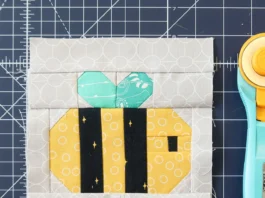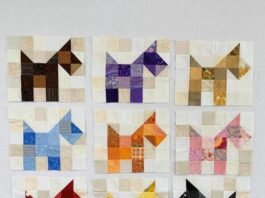Creating a Granny Square Quilt Block is a fantastic way to add a classic and vibrant pattern to any quilt project.

1. What is a Granny Square Quilt Block?
The Granny Square Quilt Block is a popular design inspired by crochet’s granny squares, a traditional motif often found in blankets and throws. It consists of small squares arranged in concentric layers, creating a visually appealing effect. In quilting, this pattern offers a structured and easy-to-manage quilt pattern that’s perfect for beginners and seasoned quilters alike.
This block is not only attractive but also highly adaptable. It can be scaled to different sizes and used as the main feature or as a complementary design within larger quilts. The color possibilities are endless, so you can play around with shades that suit your style or project theme.
As one of the most iconic quilt patterns, the Granny Square is simple enough for beginners while still offering depth for more experienced quilters. The uniformity of the small squares provides a neat look that works well for creating large quilts, table runners, pillow covers, and more.
2. Materials You’ll Need for a Granny Square Quilt Block
Before starting, it’s essential to gather all the materials. For a Granny Square Quilt Block, you’ll need various fabric colors, a rotary cutter, a cutting mat, and a quilting ruler. Additionally, having a sewing machine, pins, and an iron will make the process easier and ensure professional results.
Choosing the right fabric for your Granny Square Quilt Block is vital. Opt for 100% cotton fabrics, as they are easy to sew, durable, and available in a wide range of colors and patterns. Many quilters choose three or more colors for this block to achieve a striking visual contrast.
Having the proper tools will make the process much more enjoyable. A rotary cutter ensures precise cuts, while a quilting ruler and mat help you measure your fabric squares accurately. Accuracy in cutting is essential for achieving a balanced and aligned Granny Square Quilt Block.
3. Cutting the Fabric for Your Quilt Block
The first step in making a Granny Square Quilt Block is cutting the fabric into precise squares. For this tutorial, we’ll make a 9” square block. You’ll need three different fabrics: one for the center, one for the middle layer, and one for the outer layer. Here are the exact measurements for each layer:
- Center Fabric: Cut 1 square at 2.5” x 2.5”
- Middle Fabric: Cut 4 squares at 2.5” x 2.5”
- Outer Fabric: Cut 8 squares at 2.5” x 2.5”
Cutting each square to an exact 2.5” x 2.5” is crucial for the layout and assembly. Use a rotary cutter and ruler to ensure clean, accurate cuts. Cutting errors can lead to alignment issues later in the process, so take your time with this step.
Precision in fabric cutting is essential, as it allows the blocks to fit together seamlessly. Also, consider pressing the fabric before you begin cutting, as wrinkles can distort measurements and result in uneven blocks.
4. Laying Out Your Squares in a Granny Square Pattern
Once you’ve cut your squares, arrange them on a flat surface in the Granny Square pattern. Place the single center square in the middle, surrounded by the four middle-layer squares, and finish with the eight outer-layer squares. This layout will create the iconic concentric design.
Arranging the squares on a design board or clean table helps you visualize the final look of the block before sewing. Feel free to play with different color combinations to see how they look together; this step is where creativity shines.
When you’re happy with the layout, it’s time to start sewing. Laying out the pieces ahead of time can also help you avoid mistakes, as you’ll have a clear visual of where each square belongs in the quilt block.
5. Sewing the Squares Together
To assemble the Granny Square Quilt Block, start by sewing the squares in rows. Take the top three squares and sew them together, using a ¼” seam allowance. Repeat this for each row, making sure the seams are straight and consistent. After sewing each row, press the seams open to keep the block flat.
Using a ¼” seam allowance is essential in quilting to ensure uniformity. Keep your seams straight to maintain alignment, as any inconsistencies can throw off the pattern when it’s time to join the rows. Pressing the seams open also helps reduce bulk, which is vital for smooth, flat quilt blocks.
Once the rows are complete, sew them together to form the block. Start by joining the top row to the second row, and then continue until all rows are connected. Press the block once more to finalize the shape and prepare it for further assembly.
6. Final Pressing and Trimming the Block
After sewing the rows together, give the completed Granny Square Quilt Block a final press. This step not only sets the seams but also helps the block lay flat. If necessary, trim the edges to ensure the block is a perfect 9” square.
Trimming is essential, especially if you plan to join multiple blocks for a larger quilt. Use a square quilting ruler and rotary cutter to trim any excess fabric, as this ensures uniformity in your quilt layout. A consistent size across all blocks will make the final assembly much easier.
Once your block is pressed and trimmed, it’s ready to be incorporated into your quilt project. Whether you’re making a full quilt, a pillow cover, or a wall hanging, this Granny Square Quilt Block will add charm and vibrancy to your work.
7. Variations and Tips for the Granny Square Quilt Block
One of the best aspects of the Granny Square quilt pattern is its versatility. You can experiment with different color schemes, fabric textures, and block sizes to create unique variations. For example, try using patterned fabric for an added visual effect or incorporating larger squares for a bigger, bolder block.
Another way to add variation is by adjusting the block size. If you’re looking to make a larger quilt, consider making your squares 3” x 3” instead of 2.5” x 2.5”. This adjustment can add a bit of dimension to the design and make the final quilt quicker to assemble.
For a cohesive quilt, maintain a consistent color palette. Sticking with colors that complement each other will help create a visually pleasing quilt pattern without feeling too chaotic. Or, if you prefer a scrappier look, mix and match fabrics for a fun and colorful result.
8. Assembling a Quilt with Granny Square Blocks
Once you have multiple Granny Square blocks, it’s time to assemble them into a quilt top. Arrange the blocks in a grid or experiment with different layouts to find what works best for your design. Once you’re happy with the arrangement, sew each block together with a ¼” seam allowance.
Be sure to align the seams carefully as you join the blocks. Matching seams at intersections will give the quilt a polished look, so take your time here. Press each seam open after sewing to keep the quilt top flat and smooth.
After assembling the top, layer it with batting and backing fabric. This process completes the quilt assembly, allowing you to quilt and bind it according to your preferred method.
9. Finishing Touches and Quilting the Granny Square Quilt
To finish your Granny Square Quilt, consider adding a quilt binding that complements the colors in the blocks. Binding is the last step in any quilt project and serves to frame the design and secure the edges. Choose a binding fabric that matches the quilt or adds a pop of contrast.
Quilting the completed quilt top adds texture and durability. You can opt for straight-line quilting or try a more intricate design to highlight the Granny Square quilt pattern. Quilting helps stabilize the layers and gives the quilt a beautiful, finished look.
Once the binding is attached, your Granny Square Quilt is ready for use or display. This timeless design is perfect for adding warmth and style to any room, making it a rewarding and beautiful quilt project. Enjoy your creation and the craftsmanship that went into each squ



